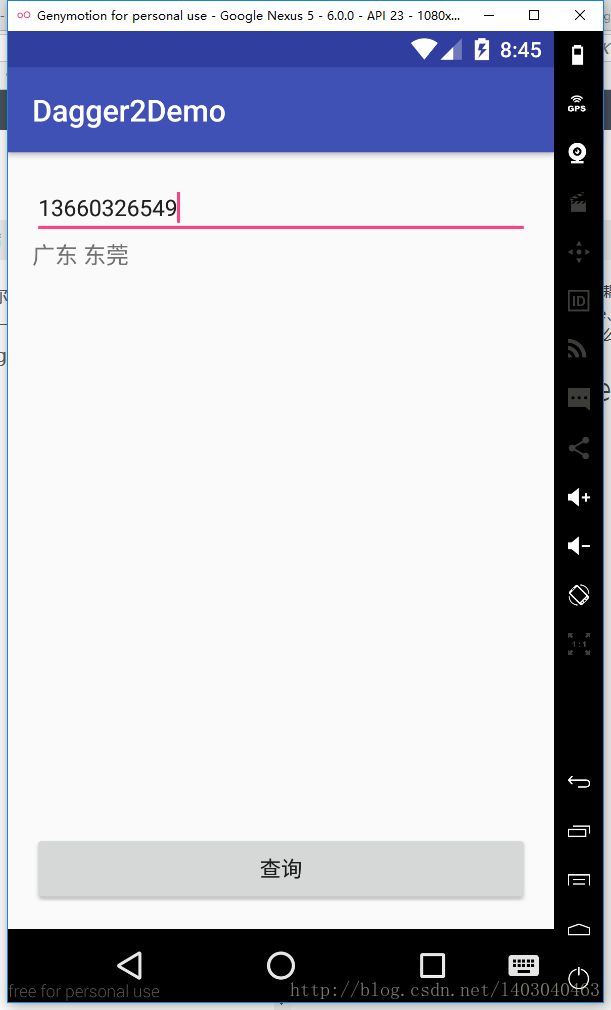Android MVP+Dagger2使用教程
Dagger2是一个依赖注入框架,在解耦合方面堪称强大。如果你还不知道什么是依赖注入,以及使用Dagger2的原因,那么还是麻烦你先去google、百度一下,这里我暂时不会涉及dagger2的原理,而是使用一个非常简单的MVP例子来应用dagger2。为什么要使用MVP的例子讲解呢?因为dagger2和MVP是天造地设的一对~、
一、不使用dagger2的MVP Demo
这个MVP Demo非常简单,模拟手机号码归属地查询的实现。如下图,在EditText中输入手机号码,点击查询按钮,就会显示出手机号码所归属的省市。PS:为了简(偷)便(懒),这里并不存在网络请求,我只是模拟了这一过程而已,所以手机号输入可以是随意的字符即可,只要保证EditText的内容不为空就可以了,各位见怪勿怪哈哈哈~

MVP分为model、view、和presenter,其中Activity承担View的角色,只负责控件的显示和更新。model负责业务逻辑和各种数据实体,presenter则负责连接Activity。
1、View
首先是IQueryView.java
public interface IQueryView {
//查询成功后,显示手机归属地的查询结果
void showSuccessMsg(String successMsg);
//查询失败,显示失败原因
void showErrorMsg(String errorMsg);
}然后在MainActivity中实现该接口:
MainActivity.class
public class MainActivity extends AppCompatActivity implements IQueryView,View.OnClickListener{
//输入手机号码
EditText et;
//显示查询结果
TextView tv;
Button btn;
//presenter的实现在下面
public QueryPresenter presenter;
@Override
protected void onCreate(Bundle savedInstanceState) {
super.onCreate(savedInstanceState);
setContentView(R.layout.activity_main);
et= (EditText) findViewById(R.id.et);
tv= (TextView) findViewById(R.id.tv_res);
btn= (Button) findViewById(R.id.btn_query);
presenter=new QueryPresenter(this);
btn.setOnClickListener(this);
}
//在TextView中显示查询结果,Activity只负责View的更新和显示
@Override
public void showSuccessMsg(String successMsg) {
tv.setText(successMsg);
}
//查询失败时,Toast提示
@Override
public void showErrorMsg(String errorMsg) {
Toast.makeText(this,errorMsg,Toast.LENGTH_LONG).show();
}
//点击查询按钮时,将查询逻辑交给Presenter
@Override
public void onClick(View view) {
presenter.query(et.getText().toString().trim());
}
}2、Presenter
Presenter负责连接view和model,view无法直接获取model的数据,model也无法直接操作view,即实现了view和model之间的完全解耦。Presenter和View、Presenter和Model之间的通信都是使用接口。
QueryPresenter.java:
public class QueryPresenter implements OnQueryListener{
private IQueryView view;
public QueryModel model;
public QueryPresenter(IQueryView view){
this.view=view;
model=new Model();
}
//使用model发起网络请求
public void query(String phoneNumber){
model.queryNumber(phoneNumber,this);
}
@Override
public void onSuccess(String successMsg) {
//通知View更新
view.showSuccessMsg(successMsg);
}
@Override
public void onError(String errorMsg) {
view.showErrorMsg(errorMsg);
}
}onQueryListener.java:连接Presenter和Model
public interface OnQueryListener {
//model通知presenter查询成功
void onSuccess(String successMsg);
//model通知presenter查询失败
void onError(String errorMsg);
}3、Model
model代表业务逻辑和数据实体,在这里,model完成手机号归属地查询的网络请求(模拟)
QueryModel.java:
public class QueryModel {
public QueryModel(){}
/**
* 模拟手机号码归属地查询
* @param phoneNum
* @param listener
*/
public void queryNumber(String phoneNum, OnQueryListener listener){
//模拟网络请求,请求结果为广东 东莞
String result="广东 东莞";
//通知Presenter
listener.onSuccess(result);
}
}好了,完整的MVP Demo就是这样了。可以看到,我们在MainActivity中需要实例化Presenter:
presenter=new QueryPresenter(this);在QueryPresenter中我们还需要实例化Model
public QueryPresenter(IQueryView view){
this.view=view;
model=new Model();
}这就是所谓的依赖,MainActivity依赖QueryPresenter,QueryPresenter依赖QueryModel。在大型项目中,一个类可能依赖多个其他的类,需要书写类似A a=new A( )的代码就会很多很繁琐,而使用dagger2就可以省去很多代码量,更重要的是,降低耦合度,让程序结构更清晰,易于维护和测试。
二、使用dagger2的MVP Demo
1、引入dagger2的准备工作
在project–build.gradle中添加apt插件。PS:apt插件不止这一种
build.gradle:
// Top-level build file where you can add configuration options common to all sub-projects/modules.
buildscript {
repositories {
jcenter()
}
dependencies {
classpath 'com.android.tools.build:gradle:2.2.3'
//添加apt插件
classpath 'com.neenbedankt.gradle.plugins:android-apt:1.8'
// NOTE: Do not place your application dependencies here; they belong
// in the individual module build.gradle files
}
}
allprojects {
repositories {
jcenter()
}
}
task clean(type: Delete) {
delete rootProject.buildDir
}在app–build.gradle中添加依赖,记得在上方添加:
apply plugin: 'com.neenbedankt.android-apt'app-build.gradle:
apply plugin: 'com.neenbedankt.android-apt'
....
dependencies {
compile fileTree(include: ['*.jar'], dir: 'libs')
androidTestCompile('com.android.support.test.espresso:espresso-core:2.2.2', {
exclude group: 'com.android.support', module: 'support-annotations'
})
compile 'com.android.support:appcompat-v7:25.3.1'
testCompile 'junit:junit:4.12'
//dagger2和Java注解的依赖
compile 'com.google.dagger:dagger:2.11'
compile 'org.glassfish.main:javax.annotation:4.0-b33'
//注意是apt而不是compile
apt 'com.google.dagger:dagger-compiler:2.11'
}好了,准备工作做好了,可以开始使用dagger2了
2、应用dagger2
首先在需要被实例化的依赖对象的构造函数中添加注解@inject
先举个简单的例子吧,QueryModel的构造函数不需要参数,也就是默认的无参构造函数:
@Inject
public QueryModel(){}然后在需要用到QueryModel的类QueryPresenter中也添加@inject注解(在对象声明处添加)
@Inject
public QueryModel model;在这两个地方都添加了@inject依赖就意味着告诉dagger,我这个model对象是需要实例化的,当用到model时,你就使用被@inject的构造函数来实例化这个model吧
那现在问题是谁来实例化这个对象?于是就轮到Component出来了:
QueryPresenterComponent.java:
@Component
public interface QueryPresenterComponent {
void inject(QueryPresenter presenter);
}注意上方的@Component注解,其中的inject()方法表明该Component是可以为QueryPresenter进行依赖注入的。还要注意一点,该类必须是抽象类或者接口,
最后,我们需要在Presenter中实时地声明对类对象进行依赖注入,原本的model=new QueryModel( )就不需要了。
注意:我们使用了DaggerQueryPresenterComponent,这个类是Dagger2自动为我们生成的,命名规则是在我们刚刚创建的类QueryPresenterComponent前面加上Dagger。在make project之后我们才能使用这个类。
public QueryPresenter(IQueryView view){
this.view=view;
//model=new QueryModel();
DaggerQueryPresenterComponent.builder().build().inject(this);
}好了,修改完毕后重新运行程序,运行结果是一样的。
现在有个问题就是QueryPresneter的实例化,也就是在MainActivity中的依赖注入。这时候操作基本和上面差不多,但是要发现的一点是QueryPresneter的构造函数是需要一个参数的:
public QueryPresenter(IQueryView view){
this.view=view;
DaggerQueryPresenterComponent.builder().build().inject(this);
}来,我们一步一步来
首先,还是添加@inject
在QueryPresenter构造函数和MainActivity对象声明处添加注解:
@Inject
public QueryPresenter(IQueryView view){
this.view=view;
DaggerQueryPresenterComponent.builder().build().inject(this);
} @Inject
public QueryPresenter presenter;然后就是创建Component了,但是这次稍有不同,在创建Component之前我们先创建Module
Module你可以理解为对象提供参数。Component能为对象选定构造函数然后创建对象实例,那构造函数中需要的参数呢?就要由Module来提供了
MainActivityModule.class:
@Module
public class MainActivityModule {
private IQueryView view;
//参数通过构造函数传入
public MainActivityModule(IQueryView view){
this.view=view;
}
//提供参数
@Provides
public IQueryView provideQueryView(){
return view;
}
}注意上方的@Module注解
我们在MainActivityModule的构造函数中传入QueryPresenter所需要的参数
然后使用@Provides注解注明provideQueryView()适用于提供参数的。
当Component找到以下被@inject的构造方法时,会发现凭借自己无法提供IQueryView 参数,然后就会前往它所关联的Module看其能否提供参数,那么接下来就是把Component和Module进行关联了
@Inject
public QueryPresenter(IQueryView view){
this.view=view;
DaggerQueryPresenterComponent.builder().build().inject(this);
}再然后,创建Component并关联Module
Component的命名规则一般是:谁需要依赖注入,就在谁的名字后面添加Component,像MainActivity需要注入QueryPresenter,那么在类名就是MainActivityComponent了。
@Component(modules=MainActivityModule.class)
public interface MainActivityComponent {
void inject(MainActivity activity);
}注意上方的@Component(modules=MainActivityModule.class)
最后,就是在MainActivity中,显示声明依赖注入了,记得先make project
@Override
protected void onCreate(Bundle savedInstanceState) {
super.onCreate(savedInstanceState);
setContentView(R.layout.activity_main);
et= (EditText) findViewById(R.id.et);
tv= (TextView) findViewById(R.id.tv_res);
btn= (Button) findViewById(R.id.btn_query);
btn.setOnClickListener(this);
// presenter=new QueryPresenter(this);
DaggerMainActivityComponent.builder().mainActivityModule(new MainActivityModule(this)).build().inject(this);
}好了,完整流程就是这样啦,最后附上源码
源码下载